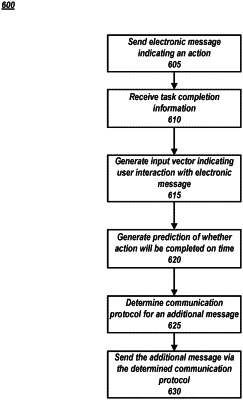| CPC H04M 1/724 (2021.01) [G06F 18/214 (2023.01); G06N 20/00 (2019.01)] | 20 Claims |

|
1. A system for using machine learning models to determine alternative communication protocols for sending messages, the system comprising:
one or more processors and computer program instructions that, when executed, cause the one or more processors to perform operations comprising:
sending a first electronic message via a first electronic communication protocol to a user device associated with a user, the first electronic message including an action request, wherein the first electronic message comprises a link and a date for completing an action associated with the action request;
receiving a data structure comprising a plurality of action requests and a corresponding result for each request of the plurality of action requests indicating whether the user timely completed the request;
determining that the action request has not been completed by the user;
in response to determining that the action request has not been completed by the user, generating an input vector for a machine learning model, wherein the input vector comprises first data from the data structure, second data associated with the action request, and user interaction information associated with the first electronic message;
based on inputting the input vector into the machine learning model, obtaining a prediction indicating that the user will not timely complete the action associated with the action request;
inputting the first data from the data structure into a reinforcement learning model, wherein a set of actions associated with the reinforcement learning model comprises sending a modified version of the first electronic message via the first electronic communication protocol and sending a second electronic message via a second electronic communication protocol; and
based on generating, via the reinforcement learning model, a recommendation to send the second electronic message via the second electronic communication protocol, sending the second electronic message via the second electronic communication protocol to the user device.
|